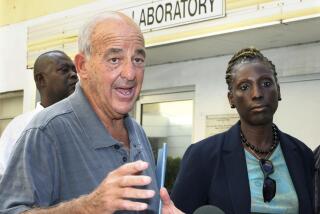A Slippery Slope to the Real Dr. Death
- Share via
Jack Kevorkian insists he is not obsessed with death.
During his medical residency, Kevorkian donned a black arm band and asked to work the night shift because more patients died then. He carted around a camera to photograph patients’ eyes at the moment of death. Coworkers nicknamed him Dr. Death, and he jokingly called his late-night quest “the death rounds.” This is detailed in “Appointment with Doctor Death,” the book by Detroit reporter Michael Betzold.
But Kevorkian is not obsessed with death.
An accomplished artist, Kevorkian’s paintings are filled with detached organs and severed heads. Maggots, blood and bullets. Skulls and suffering. Cannibalism. His artistic rendering of Christmas shows Santa’s boot crushing a baby lying in a fireplace. Religion is a favorite target: In a painting titled “Give Us This Day,” a half-man/half-baby is shown eating the flesh off a decomposing corpse.
But he’s not obsessed with death.
Early in his career, Kevorkian advocated medical experimentation on death row inmates. He has since expanded on the idea by suggesting that condemned prisoners be allowed to auction off their organs. At one point, he proposed that anyone sentenced to more than three years in prison be given the option of assisted suicide.
Over at Pontiac General Hospital, he experimented with transfusing blood from corpses into live patients. (Former guinea pig Neal Nicol once got such a severe case of hepatitis from cadaver blood that his eyeballs turned orange.) Kevorkian even mixed cadaver blood with his own and used it to paint the frame for one of his works.
But he’s not obsessed with death.
Public support is high for Kevorkian’s crusade. According to a recent Gallup poll, about 75% of Americans now favor physician-assisted suicide. To many Americans, Kevorkian is a compassionate if eccentric man who wants nothing more than to end people’s suffering. But do those same Americans know the Jack Kevorkian who once tried to organize an exhibit of Adolf Hitler’s artwork; the Kevorkian who said carbon monoxide gives corpses a “lovely rosy glow”; the Kevorkian who said Jesus Christ would have been better off dying in the back of his rusty van?
Kevorkian has been generating corpses at an accelerated pace since May, when he was acquitted for a third time of violating Michigan’s ban on assisted suicide. In mid-August, Kevorkian broke his own record by performing four so-called “medicides” in a week. “Now he really feels he’s off and running, and no one can stop him,” said Yale Kamisar, a University of Michigan constitutional law professor and expert on the issue of assisted suicide. “It’s unlikely that he’ll ever be convicted unless he makes a mistake.”
Mistake? Take the case of Rebecca Badger, Kevorkian suicide No. 33. This 39-year-old mother of two was depressed and in pain. Her doctors diagnosed her with multiple sclerosis. On July 9, Kevorkian “treated” her. One problem. Badger didn’t have MS.
Just five weeks after Badger’s death, Kevorkian “assisted” 42-year-old Judith Curren. Kevorkian attorney Geoffrey Fieger said Curren suffered from chronic fatigue and immune-deficiency syndrome, as well as the muscle disorder fibromyalgia. But the Oakland County medical examiner said he could find no evidence of any disease in Curren. Even if he had, none of Curren’s maladies is considered fatal.
The Oakland County medical examiner said he did find that Curren likely was worn out from carrying 269 pounds on a 5-foot, 1-inch frame. Curren probably experienced depression--90% of chronic-fatigue sufferers do. She took potentially addictive drugs. Reports also surfaced widely that Curren had accused her husband of domestic abuse, prompting speculation that she was looking to escape a bad marriage. So what if Curren in fact wasn’t terminal? “It has nothing to do with lethality, it’s quality of life” Kevorkian said on “Dateline NBC.”
Will Dr. Death ever quit? After his third acquittal, Kevorkian said the only way to stop him would be to burn him at the stake.
Opponents of physician-assisted suicide say Kevorkian is a bizarre man on the fringe of medical practice. Rita Marker, executive director of the International Anti-Euthanasia Task Force, said Kevorkian already has reset the boundaries of acceptability in the United States. In comparison with Kevorkian, a suicide doctor with a Marcus Welby-like demeanor will suddenly seem eminently reasonable.
“There will be those who will be Kevorkian with class,” Marker said. “They will look respectable. They will sound respectable. Their patients will be just as dead.”
Welcome to the slippery slope.
More to Read
The biggest entertainment stories
Get our big stories about Hollywood, film, television, music, arts, culture and more right in your inbox as soon as they publish.
You may occasionally receive promotional content from the Los Angeles Times.










